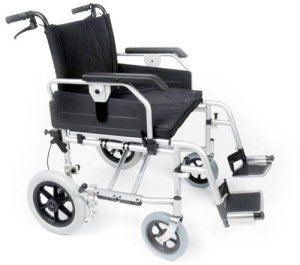The Next Big Trend In The Bariatric Wheelchair 24 Inch Seat Industry

Bariatric Wheelchair Seat Width
Seat Width

Having the proper seat width is necessary to wheelchair users who spend longer durations in their chairs. Too narrow a seat will trigger pressure on the hips and thighs which could result in sores or pressure points. Having too wide a seat can also make it tough for the user to reach the hand rims to move themselves or maneuver in little areas.
To determine the appropriate seat width an individual would rest on a chair typically and have their measurement taken throughout their lap at the widest point which is usually their hips. A wheelchair determining tape can be utilized to determine this, however a backyard stick is preferred as it avoids individuals from covering the tape around their hips which would provide an incorrect result.
The standard wheelchair seat width is 16" (narrow adult), 18" (standard adult), and 20" (broad grownup). For bariatric patients, a 24" seat is available. This heavy-duty extra broad bariatric wheelchair from Medline includes swing-away footrests, a carbon steel frame with rust- and chip-resistant chrome plating, and easy-to-clean vinyl upholstery. It has a weight capacity of 500 pounds.
Seat Depth
Traditionally, the seat depth of a bariatric wheelchair was included 2" to the measurement taken at the user's widest point (normally their hips). This was suggested to accommodate extra layers of clothing that might be used during cold weather. Nevertheless, bariatric wheelchair 22 inch is ending up being less common as wheelchair users are able to invest more time inside your home and are not using long coats. This makes the seat depth of a chair lesser when choosing a bariatric wheelchair. However, it is still essential to choose an option that uses sufficient support for larger users.
The Medline folding additional broad bariatric manual wheelchair features a comfortable 24" seat width and a sturdy slide tube silver vein frame. It likewise has an adjustable axle and tool-free raising legrests.
Seat Height
When it pertains to determining the correct wheelchair seat width you need to constantly measure from the user's best point which is normally their hips. You will also need to consider whether the user is going to be using a winter coat as this may add 2" to the width needed.
When a wheelchair remains in use it should just be run on level surfaces with the wheel locks fully engaged. This is to avoid the chair from being able to move inclines that are 10 degrees or greater. It is also essential to bear in mind that any activity that might shift the center of gravity in the chair should be done with care. This includes reaching for products that require the individual to lean out of their seat or attempting to stand up from it.
Whenever you have the chair in usage it is suggested that you regularly check it for damage and lubricate any locations that are deemed required. For example, the casters ought to be oiled by getting rid of the caster fork and utilizing a multi-purpose grease to apply to the caster stem bearings. Also, the foot plates can be adjusted by loosening up the bolt and after that moving them to the desired position. This allows the feet to sit comfortably on the footplate and avoids any pressure points from forming. This can be really uneasy for the user and if left unattended, can result in push sores.
Weight Capacity
Bariatric wheelchairs are created to support more weight than basic wheelchairs. This makes them tougher and much better equipped to deal with falls. They are likewise typically larger and larger, making them less maneuverable in tight areas than standard wheelchairs. They require cars with unique ramps and lifts to load them, in addition to drivers who understand how to best transport them from one location to the next.
When selecting a wheelchair, consider its weight capacity as it will be the primary determining element in whether it will accommodate your passenger's needs. The weight capacity of the chair is typically noted as a fixed load, meaning that it suggests the amount of weight the chair can conveniently hold while stalling. Nevertheless, some manufacturers also note an active load that is based upon a drop test and can mimic the impact of someone sitting down in the chair. This might be a more trusted measurement of the weight limit, depending on your requirements.
If you prepare to perform activities that move your center of mass in the seat (such as reaching for objects), be sure to have front casters pointed in a forward direction and wheel locks engaged so the chair will not topple. Also, inspect that casters are oiled routinely to avoid excessive wear and abrasions. The lubrication treatment involves eliminating the fork, separating the caster from the wheel, and greasing the caster stem bearings with high-quality multi-purpose grease.
